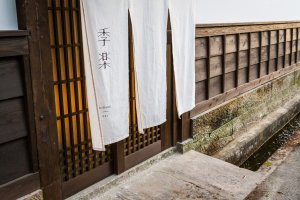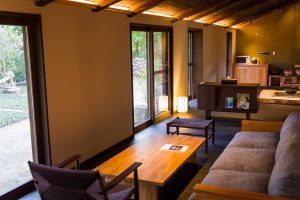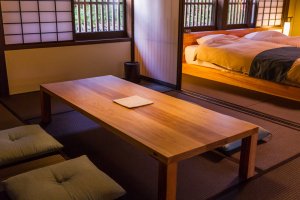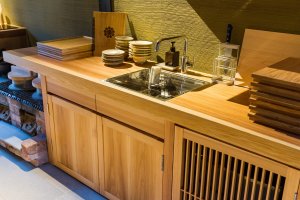When a translator works to change one language into another, its not simply a matter of substituting dictionary equivalents of words—instead they artistically create anew a similar thought in the brain of a speaker of the second language, imagining what this person would say in the same situation. What works with words may also work with architecture. What if one were to translate a samurai residence into the modern world?
One way to do it would be to find the remnants of a historic structure and rebuild it with contemporary materials and modern conveniences that harmoniously maintain the aura of the 17th century. Wood and stone are true to both eras here and constitute the bulk of the building’s mass. Yet we can enhance these with electric lighting. Keep the tatami mats and hardwood flooring as well as the natural fabrics of the bedding, sofa, and sliding paper doors. Maybe even have a pine bathtub—but augment all of these with indoor plumbing, an instant water heater, energy-efficient heating and air conditioning, a high-tech toilet, and upscale modern kitchen appliances. Working within the spirit of historic upper-class life, you could hire local artists to craft solid-wood tables and other furnishings, fill the kitchen with fine cutlery, cookware, and ceramics, and decorate the interior to make it unmistakably Japanese. You could even place the residence near a castle among other historic buildings—and that’s just what was done with a home called Ohya (and its sister residence, Katsume).
At the foot of the little countryside town of Obi’s castle grounds sits a grid of streets filled with residences of the local lord’s loyal retainers, organized by rank and privilege in its layout. Common to such castle towns, streams along the streets brim with show carp, and houses hide behind stone walls and hedges of traditional Japanese flowers such as azaleas and camellias.
Step across the flowing carp stream and though the curtain into the old nagaya-mon, or gate-house, for an Edo period samurai estate. This is Ohya, where you can live for a day or more in luxurious history.
Ohya features a traditional elevated wooden floor that retains a sunken hearth for atmosphere. There’s an unusual sense of openness here for a Japanese home, with high ceilings as well as a wall of windows looking out into the garden and vast yard. The Japanese room with a traditional low table features gorgeous and rare dark-colored tatami mats that match perfectly the deep brown of the hardwood floors. The house sleeps six on either beautiful futon-like beds or more traditional futons.
With real insight, the company that developed this building, Kiraku, not only restored this building beautifully and make it accessible to visitors, they also even provide those interested in the craftsmanship with the names and records of the artists who fashioned everything from the coffee cups to the dining room table to the tissue boxes. The crafts are locally made, and you can even visit the shop of something you particularly like.
It’s a curious exercise to contemplate what feels like the 17th century, yet is most certainly the 21st. Ohya makes a fine base to explore this old castle town as well at the rich Miyazaki countryside and dramatic Pacific coastline.







































